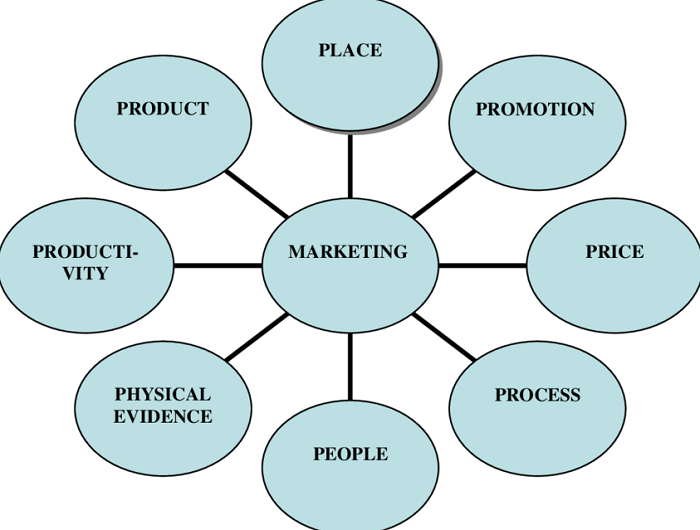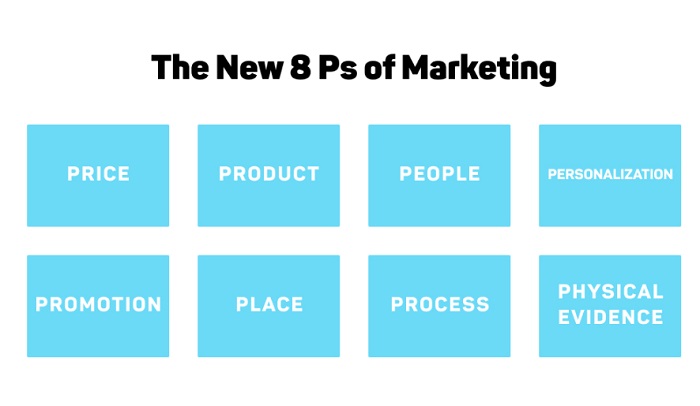The marketing mix framework is a powerful tool that can connect you with your target audience and guide your marketing efforts. By using this approach, you can effectively market your products or services and achieve your business goals. A Marketing mix evolves into the most popular and result-oriented marketing strategy: the 8 Ps of marketing.
For a marketing mix that’s truly effective, you must take into account the 8 Ps of marketing: product, price, place, promotion, people, positioning, processes, and performance. When these components are properly aligned, you’ll have the ability to more effectively engage and convert potential customers.
In this article, we will demonstrate how utilizing the 8 Ps of marketing can improve the growth of your business.
What Are The 8Ps Of Marketing?
The holistic marketing mix is critical to the business’s success. These 8Ps of marketing can help your business grow and expand and reach beyond its potential.

Using these 8Ps of marketing can undoubtedly boost your marketing strategies and achieve your targets.
See Also: What Is Performance Marketing And How To Get It Started?
Product
The first P symbolizes the product. Product is what you provide, either service or products. They fall under the category of both tangible and non-tangible assets.

The product can convert your potential customer into your identifiable brand ambassador, and products from your company can serve as a piece of marketing equipment in themselves. The firm needs to understand and broadcast the problem the product aims to solve. As a business owner, you’ll need a thorough understanding of what Channel Marketing is and how it delivers goods to consumers from the sites where they are made.
For instance, a college sells higher education as its product, and other schools and colleges surrounding it are its competitors. Every product/service has a specific life cycle; it is vital to understand how it will function throughout.
Price
Price is essential in determining the success of a business. It covers the amount the user will pay for the product. How the product will be sold will depend on the price of the product. Predictions are made about the perceived product the customer shall pay for once the product is out in the market.
If the fixed price of the product is higher or lower than the expected/perceived value, then fewer people would buy the product in the market. Thus, the study of pricing becomes essential for the product’s success.

Price gets affected by many factors like the distribution plans of the product in different geographical areas, the cost of the value change and markup, and the price of the competitor businesses for the same product. Pricing highly affects the USP. While fixing the price value of a product, the factors that must be taken into consideration are:
- The cost(variable and fixed)
- Competition in the market
- The objective of the product
- Aim of the company
- Target audience
Numerous strategies will decide the price, and corporate factors drive the price target.
Placement
The place is elaborated as a marketing channel (indirect and direct). Geographical areas of distribution coverage, outlets, location of the marketplace, the exhibition catalogs, logistics and transportation, inventory of the firm, and fulfillment of the placed orders.
It refers to the feasible physical location where the business is set up or the company’s outlet stores that are used for distribution in the market.
This essential marketing element includes the fundamental choice of where the product should be displayed and available to the customers. Placement also consists of where the stores(wholesale, retail) should be established for growing sales.
A firm’s major accomplishment is bringing its product into the limelight, especially in the eyes of the consumer who wants to buy them. Placement may sound like putting the product in various outlets, but it also means showcasing the product on a store’s display or a web page.
Promotion
Promotion means “Marketing communication to make the offer known to customers and persuade them to dig in further.”
It is the eighth P of the marketing mix. It specifically aims to make consumers better aware of the product and convince them to buy it. Promotion helps inform and influence the consumer, requiring decisions about the advertisement, personal selling, and sales promotion. Each of these techniques assists in promotion and survival through competition in the market.
Extending markets and increasing competition have made concurrent use of more than one method of promotion far more essential. Combining two or more promotional campaigns calls for efficient mixing of promotional inputs to maximize each campaign’s cost. One must consider the type of consumer, the promotion budget, stage of demand, etc., while composing a promotional mix product’s nature.
It is also related to the other three Ps of marketing, as promoting the product helps customers to understand its need and why the specific price is appropriate for them. Also, marketers usually combine promotion and placement strategies to reach their target audiences.
See Also: What is Direct Response Marketing? Best Direct Response Marketing Techniques
People
Every company relies on the people who run them, from the leading edge sales staff to the Managing Director. Marketing will be just as great as the staff of the company. It is essential to have the right person in the correct position because they value the same product/service offered by the company.

Staff reflects a stat that marketers should view their customers and entertain their needs to comprehend their lives in a more specific way for their products and services.
Processes
Without a perfect process, the creative and structural management of marketing is disturbed. Hence, marketers must follow the marketing management process as only an approach provides the right guide, bringing long-term benefits.

A process plays a significant role in bringing discipline and perseverance. Before any management, how the surface is to be delivered, that is, “the process,” is essential.
Programs
The program contains all the company’s customer-centric activities. Moreover, it surrounds the previous four Ps and other marketing techniques, which may not adjust as clearly in the old view of marketing.
Whether virtual or non-virtual, traditional or non-traditional, it is always important to combine various creations so that the total is always greater than that of parts, and the aim is to clear multiple objectives of the company.
Like the other 7, some people also add packaging to this list. The logic behind the product’s presentation is critical as it gives the first impression to the customer. However, some disagree with this and consider packaging a sub-field of promotion.
Performance
Performance includes accomplishing the task that contributes majorly toward the company’s financial stability, ethical, social, and reputation. It sometimes also includes achieving a range of measures that can push the company beyond its potential. Performance stands more for the improvement of the company on its ground rather than for the entire business.
Eight P, i.e., performance, has originated from the emerging productivity and the quality of the business. Also, please take into consideration the financial goals of the company and whether they are achievable or not. Performance is recognized by how productively a company works and the quality of the product sold in the market.
Continuous growth needs improvements at every stage of the performance.
Describe The Marketing Mix
Integral marketing is a marketing combination that provides a framework for approaching your marketing strategy for your products or services. And it centers on your intended audience. It aids in customer resonance. Additionally, it guides marketing management across divisions in your firm.
You can attain business objectives with many factors collaborating and an excellent marketing strategy.
The four Ps of marketing—product, place, pricing, and promotion—were founded on the original marketing mix, a top-down administrative plan. It then evolved into the well-known 7 Ps marketing mix by adding people, processes, and positioning. The Seven Cs Compass Model, too. You prefer to take things further if you’re anything like us, though.
Performance is an additional P in the 8 Ps. These eight Ps are more beneficial for a contemporary marketing mix.
How Does A Marketing Mix Appear?
In my youth, I recall Weed Man as adept at bringing all this together. They are an outstanding illustration of a service marketing mix. It is a weed-killing service whose primary offering and sales promotion combine to create a marketing spectacle. They effectively blend aspects of the marketing mix to sell their offer and attract clients.
By how lush the lawn looks, their main commodity sells itself, and their sign is also one of their multifaceted advertising strategies. It warns people to be cautious since there are chemicals here. And that by merely dialing the phone, they can likewise enjoy a lush lawn. Even a referral scheme exists.
These additional marketing mix components efficiently support marketing goals.
How Are The Eight Pillars Of Marketing Integrated?
All eight of these marketing tenets are necessary for marketing to succeed. Together, developing a comprehensive and potent marketing plan. They all play a crucial role in creating a compelling and whole picture, much like the parts of a puzzle.
See Also: The Process of Integrated Marketing Communications
Who developed the 8 Ps of marketing?
In 1960, E. Jerome McCarthy created the 4 Ps definition of business ethics. Philip Kotler first described the marketing mix as a group of elements that might be managed in 1967. McCarthy is a prolific author of business administration, marketing, and advertising books. He was an American who taught marketing at Michigan State University.
The Person Who Came Up With The 8 Ps Of Marketing
Professor McCarthy recommended using the 4 Ps marketing mix to develop a marketing strategy in his book, “Basic Marketing: A Management Perspective.”
The fundamental four Ps of marketing were later supplemented with the seven Ps. In their 1981 publication, Marketing strategies and organizational structures for service organizations, professors Bernard Booms and Mary Jo Bitner introduced the 7Ps of the marketing mix.
Because it’s easy to understand and put into practice, the 8 Ps definition, which complements the 7 Ps definition with performance, has been extensively accepted by businesses across all industries.
The Most Important P In The 8 Ps Of Service Marketing
Any service or experience must prioritize its customers. Services are frequently produced and consumed simultaneously, and elements of the customer experience are changed to cater to the specific requirements of the person consuming it.
FAQs
Who invented the 8Ps of the marketing mix?
Professor McCarthy, in his book 'Basic Marketing: A Managerial Approach,' put forward The 4Ps of the marketing mix to help develop marketing strategies. Later these 4Ps were extended to 7Ps. After some time, performance was added to the list and was widely accepted by marketers as it was easy to apply.
How do the 8Ps of marketing mix work together?
To achieve success, each of the eight Ps is important in marketing. Together they all work to form an adaptable and efficient marketing strategy. They all work together to form a successful and whole picture, much like the parts of a jigsaw.
Which P is most important in the marketing mix?
The Price. It is because presently, price match has become very much important, so that is why the price is the most popular P in the marketing mix.
Conclusion
The essential elements of the complete marketing mix are these 8Ps. In the past few years, it has been evident that they have contributed to the development of the marketing field. These 8Ps are interrelated to each other, and maintaining the balance between eight of them leads to an exponential rise in the business. The marketing field has increased tremendously in the last few decades. There is still in-depth research on these highly essential 8Ps of marketing.






